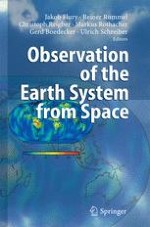In the recent years, space-based observation methods have led to a subst- tially improved understanding of Earth system. Geodesy and geophysics are contributing to this development by measuring the temporal and spatial va- ations of the Earth’s shape, gravity ?eld, and magnetic ?eld, as well as at- sphere density. In the frame of the GermanR&D programmeGEOTECHNO- LOGIEN,researchprojectshavebeen launchedin2002relatedto the satellite missions CHAMP, GRACE and ESA’s planned mission GOCE, to comp- mentary terrestrial and airborne sensor systems and to consistent and stable high-precision global reference systems for satellite and other techniques. In the initial 3-year phase of the research programme (2002-2004), new gravity ?eld models have been computed from CHAMP and GRACE data which outperform previous models in accuracy by up to two orders of m- nitude for the long and medium wavelengths. A special highlight is the - termination of seasonal gravity variations caused by changes in continental water masses. For GOCE, to be launched in 2006, new gravity ?eld analysis methods are under development and integrated into the ESA processing s- tem. 200,000 GPS radio occultation pro?les, observed by CHAMP, have been processed on an operational basis. They represent new and excellent inf- mation on atmospheric refractivity, temperature and water vapor. These new developments require geodetic space techniques (such as VLBI, SLR, LLR, GPS) to be combined and synchronized as if being one global instrument.
